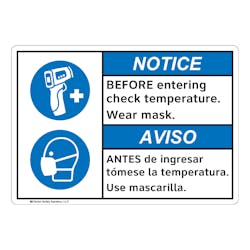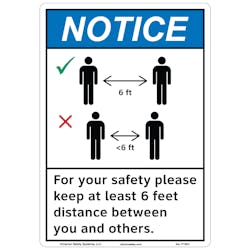Signage reminds workers of safe practices during pandemic
After a year of wearing masks and staying distant from one another, it’s clear advances in science aren’t the only keys to staying healthy. At least not yet.
While the world waits for full deployment of vaccines, some companies are leveraging their expertise in the basics. Clarion Safety Systems, which makes product safety labels and facility safety signs and tags, is one of them. Its portfolio includes safety labels for use on equipment and signs to display around the workplace. Last year, it launched a new line of products specifically dealing with COVID, to serve as reminders for physical distancing, hygiene and personal protective equipment protocols.
Floor markers, used to designate proper spacing, have become some of Clarion’s most popular sellers.
“It’s clear that companies have become more attuned to their safety sign systems recently — and more creative during the pandemic in order to be able to continually remind their workers or visitors of best-practice safety measures, such as social distancing and wearing a mask,” said Angela Lambert, the company’s head of standards compliance.
Signage has become more common in both workplaces and public spaces, said Lambert, who foresees the trend continuing.
“The practice of using a more creative approach to messaging and types of markings — including floor markings — may potentially be used after the pandemic and apart from it,” she said. “For example, after seeing the results of using floor markers related to COVID-19, facilities may now be more comfortable and receptive to deploying floor markers to reinforce or remind workers of PPE requirements in certain areas of a facility or of forklift traffic safety protocols.”
A safety expert who’s been involved in the creation of ANSI and ISO standards for product safety and visual safety communication, Lambert said she believes sign styles will continue to evolve with an eye toward more effectively communicating important information.
Signs made in violation of today’s best practices can miss the mark because they have inconsistent or incorrect color-coding or signal words. They might lack information, or fail to use recognizable or easily understood symbols. Instead of identifying a specific risk, an older sign might just say, “Danger,” which doesn’t convey the degree of harm that could be caused by coming into contact with high-voltage wires, compared with, for instance, a hot surface.
ANSI Z535 standards would use “caution” to provide a warning about hot surfaces and “danger” or “warning” to alert workers to hazardous-voltage areas, where they are at greater risk of serious injury or death.
In addition, up-to-date signs feature multiple language panels and graphical symbol panels, so they are comprehensible to non-English readers. Colors, graphics, shapes and layouts of signs should work together to convey a specific message.
“By choosing signs that are up-to-date with today’s ANSI and ISO best practices, workplaces are doing everything they can to move towards a safer, more productive environment,” Lambert said. “That’s true in our COVID-19 environment and beyond.”
Karen Hanna, associate editor
Contact:
Clarion Safety Systems, Milford, Pa., 570-296-5686, www.clarionsafety.com
About the Author
Karen Hanna
Senior Staff Reporter
Senior Staff Reporter Karen Hanna covers injection molding, molds and tooling, processors, workforce and other topics, and writes features including In Other Words and Problem Solved for Plastics Machinery & Manufacturing, Plastics Recycling and The Journal of Blow Molding. She has more than 15 years of experience in daily and magazine journalism.


